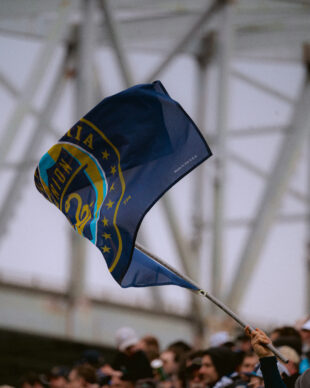Photo by: Ruairi Rossi
Saturday’s match vs. Minnesota United featured a strong professional performance from the Union. They’ve now stacked around 180 consecutive minutes of solid soccer – showing increasingly more glimpses of the superb transitional play that was part and parcel to their run to MLS Cup run in 2022.
Man-to-man press
In the first half, the Union’s diamond midfield allowed the front three to press higher up the field. This forced Minnesota into some low percentage long balls that Elliott, Glesnes, and Harriel were able to deal with, easily winning back possession for the Union.
When Philly were in possession, they could successfully progress across midfield, but the Loons would routinely press once the Union gained the halfway line. Minnesota seemingly committed to a man-to-man based press, which tightened up the first half – closing off passing lanes in an unpredictable fashion for the Union in the middle and attacking thirds.
Jim Curtin said as much during his post-game presser, “When you scout Minnesota, it’s not a crazy Red Bull press where it’s predictable and it’s 100 mph every time. [Minnesota] are pretty calculated. One of the triggers you notice, is once you cross midfield, they almost go man-to-man.”

(Action zones graphic above from Whoscored.com)
Both squad’s pressing tendencies caused much of the action in the first half to be reduced to the middle third of the pitch – until the Union were able to find a way through.
Quinn Sullivan’s speed down the right allowed the Union to stretch the gaps between the players. Curtin pointed out, “When somebody goes by somebody, now it’s almost like a domino effect… where you can start to get at them.”
The Union were also able to combat this “man-marking” with the use of long diagonal passes that slowly pulled Minnesota off of their mark. This was especially noticeable right off the bat in the second half.

(McGlynn hits a long diagonal pass to Wagner early in the second half on Saturday on Apple TV broadcast)
McGlynn and Wagner, in particular, used these diagonals to open up space for Sullivan and Harriel on the weak-side. And sometimes, vice-versa, with Harriel and Sullivan springing McGlynn or Wagner into space on the opposite side.
The Union were also a party to man-marking – but to a much lesser extent.
Jose Martinez was tasked with man-marking Minnesota playmaker Robin Lod. In the 40th minute, Minnesota had one chance in particular where Lod found space between Martinez and the Union backline, and was able to slip in Teemu Pukki who was denied by an outstretched Andre Blake leg.
In the second half, Lod was completely shut out of the game, as Martinez was glued to his hip before Lod was subbed off in the 83rd minute.
Flat 4-4-2 (the reprise)
In the 66th minute, Alejandro Bedoya was subbed on for Mikael Uhre, and the Union assumed the formation that they saw success with in Portland the week prior – the 4-4-2 with a flat midfield. Daniel Gazdag was pushed up as the second striker, and Ale settled in next to Martinez, forming a low block of four (two CBs and two 6’s).
Out of possession, the focus became getting 9-10 players behind the ball. This, coupled with the low block, lulled Minnesota into a false sense of security – thinking that they could commit more numbers forward in chase of an equalizer.
The lower block and two 6’s assembled a much more stern and compact shape. It also allowed Philly to smother Minnesota more effectively while the Union were on tired legs. Philly were able pick and choose their pressing actions at a much more calculated rate while also covering less distance.
Once Minnesota established possession in the Union half, the Loons would struggle to find a way through. The Union would force Minnesota backwards, but from much deeper in the Union half.
Not coincidentally, the opponent playing backwards also signals one of the Union’s pressing cues.
The Union’s aim was to still hit Minnesota in transition, but without the game opening up too much. The formational change allowed for this by affording Philadelphia much improved rest defense – giving the Union more numbers deeper while in possession than with the diamond midfield.
As Philadelphia would transition defense into attacks quickly through the width of Sullivan and McGlynn, Minnesota became more and more desperate. The Loons resorted to hoofing long balls forward as soon as they would gain possession in an attempt to get behind the Union before they could get numbers back.
With the Union’s height advantage, arial ability across their back-line, and improved rest defense; these desperate attempts at attacking moves by the Loons proved to be unsuccessful.
Set-piece success
The Union potted their fourth set-piece goal of the season early in the first half. Daniel Gazdag steered in a low Wagner corner along the goal-line that was flicked on by the foot of Jack Elliott into the six yard box.
We have historically seen Bedoya sit at the near post and attempt a headed flick off a driven corner as a variation to the typical corner whipped into the mixer by Wagner.
“I think you saw Kai hit a couple [corners] that were just flat and made it a jumping contest because we had, I’ll just say, a significant height advantage on the set-pieces today,” Jim Curtin noted.
“You have to have variation… Teams watch us play too, so they try to take away the strengths and weaknesses.”
Even though the second Union goal was technically from the run of play, it was preceded by an indirect restart by Oliver Semmle who nearly recorded secondary assist on the effort.
This time, it was Bedoya’s head that found rose up and deftly flicked it down into the path of Carranza for the Argentine to tuck home.
Between Glesnes, Elliott, and Harriel cleaning up arial duels in the Union’s defensive third and Bedoya’s flicked header to send Carranza in on goal, the Union had something going for them in the air and from dead ball restarts on Saturday.
Could goals off of non-PK set-pieces become a bigger share of the Union tallies in 2024, similar to how they were in 2022?


Nice analysis, particularly the bit around the low block square.
great stuff!
One of the things that I noticed was that both teams were playing extremely high back lines, which made the midfield quite clogged. Minnesota kept trying to work through the Union’s press, but they frequently ran into Jose Martinez, who mostly either forced directional changes or turnovers. Minnesota had no long ball success to speak of (and they did not play out of the back). As you astutely pointed out, the Union successfully broke the press by using long diagonal switches.
A brilliant, enlightening analysis.
Thank you for sharing your insight, plus perspective, Blake!
Great analysis. Big difference this season is players willing to dribble at the opponent and pull them apart. We were last in the league last season at attempted take ons.